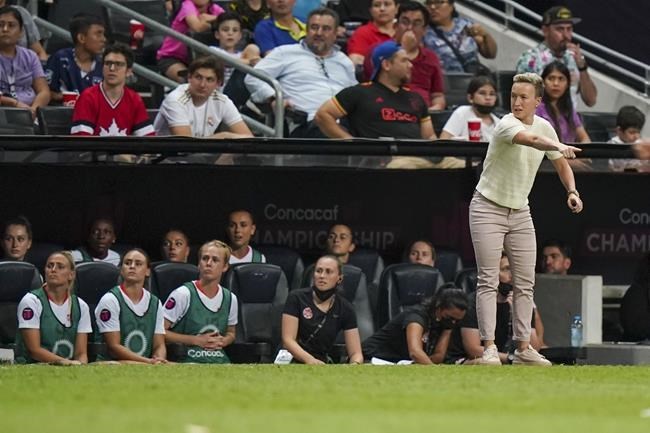Canada will learn its path at next year's Women's World Cup early Saturday with coach Bev Priestman and Canada Soccer general secretary Earl Cochrane in the audience for the draw in Auckland, New Zealand.
Former players Carli Lloyd, Alexi Lalas, Gilberto Silva and Ian Wright are among those taking part in the ceremony, which decides the eight groups for the expanded 32-team field for the soccer showcase slated to run July 20 to Aug. 20 in Australia and New Zealand.
The top two in each pool will advance to the round of 16.
Sitting seventh in the latest FIFA world rankings, the Canadian will be drawn out of Pot 2, which also includes the eighth-ranked Netherlands, No. 9 Brazil, No. 11 Japan, No. 12 Norway, No. 14 Italy, No. 15 China and No. 17 South Korea.
Pot 1 features co-hosts No. 13 Australia and No. 22 New Zealand as well as the top-ranked U.S., No. 2 Sweden, No. 3 Germany, No. 4 England, No. 5 France and No. 6 Spain.
Pot 3 is No. 18 Denmark, No. 21 Switzerland, No. 24 Ireland, No. 27 Colombia, No. 29 Argentina, No. 34 Vietnam, No. 37 Costa Rica and No. 43 Jamaica.
Pot 4 is made up of No. 45 Nigeria, the 53rd-ranked Philippines, No. 54 South Africa, No. 76 Morocco, No. 81 Zambia and three yet-to-be-decided teams from the Inter-Confederation Playoff Tournament.
The 10-team playoff tournament Feb. 18-23 in Auckland features two teams from Asia (Chinese Taipei and Thailand), two from Africa (Cameroon and Senegal), two from CONCACAF (Haiti and Panama), two from South America (Chile and Paraguay), one from Oceania (Papua New Guinea) and one from Europe (Portugal).
Ireland, the Philippines, Morocco, Vietnam and Zambia will be making their Women's World Cup debut.
FIFA's "general principle" is to ensure, where possible, that no group has more than one team from the same confederation, meaning Canada won't face the Americans in its opening pool.
But that does not apply to Europe, because of the number of possible entrants — 11 or possibly 12 depending in the playoff tournament. So each group will have at least one but no more than two European teams drawn into it.
It does mean Canada will avoid fellow CONCACAF teams Costa Rica and Jamaica, the two lowest-ranked teams in Pot 3, as well as the U.S.
But should No. 56 Haiti or No. 57 Panama qualify out of the playoff tournament, they could end up in the same group as Canada since the final qualifying competition takes place after the draw.
At the 2019 World Cup in France, Canada was drawn in a pool with the Netherlands, Cameroon and New Zealand. The Canadians finished second to the Dutch in the group and lost 1-0 to Sweden in the round of 16.
Canada was ranked fifth going into the tournament, so was in Pot 1 with host France and other heavyweights at the draw.
This time around, the Olympic champion Canadians will likely hope to be drawn with one of the host countries when it comes to Pot 1.
Canada defeated Australia twice in September, 1-0 and 2-1 in Brisbane and Sydney respectively, and is 6-2-2 against the Matildas this century.
The Canadians are 10-1-4 all-time against New Zealand, with the lone loss coming in their first meeting in December 1987. Canada won 2-0 when they met at the 2019 World Cup in Grenoble.
FIFA says some 800 guests will be in attendance at Aotea Centre, including New Zealand Prime Minister Jacinda Ardern. The draw will also mark the live debut of mascot Tazuni, billed as a "fun, football-loving penguin."
The Women’s World Cup will have two host nations for the first time. The 64 games will be played across 10 different venues in nine different cities — five cities in Australia and four in New Zealand.
Groups A, C, E and G will play their group-stage matches in New Zealand while Groups B, D, F and H will play group games in Australia.
Knockout-round matches will be split between the two countries through the semifinal, with the third-place game (Aug. 19 in Brisbane) and final (Aug. 20 in Sydney) both in Australia.
---
Follow @NeilMDavidson on Twitter
This report by The Canadian Press was first published Oct. 22, 2022
Neil Davidson, The Canadian Press



